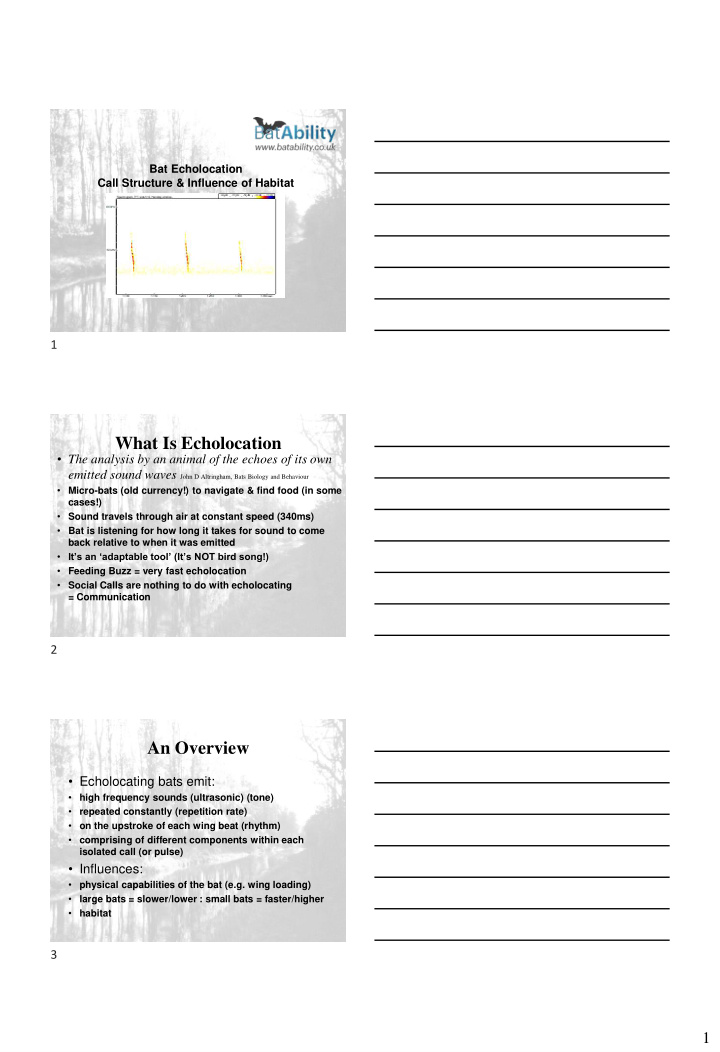



Bat Echolocation Call Structure & Influence of Habitat 1 What Is Echolocation • The analysis by an animal of the echoes of its own emitted sound waves John D Altringham, Bats Biology and Behaviour • Micro-bats (old currency!) to navigate & find food (in some cases!) • Sound travels through air at constant speed (340ms) • Bat is listening for how long it takes for sound to come back relative to when it was emitted • It’s an ‘adaptable tool’ (It’s NOT bird song!) • Feeding Buzz = very fast echolocation • Social Calls are nothing to do with echolocating = Communication 2 An Overview • Echolocating bats emit: • high frequency sounds (ultrasonic) (tone) • repeated constantly (repetition rate) • on the upstroke of each wing beat (rhythm) • comprising of different components within each isolated call (or pulse) • Influences: • physical capabilities of the bat (e.g. wing loading) • large bats = slower/lower : small bats = faster/higher • habitat 3 1
4 Pipistrellus spp. Freq (kHz) detail 55kHz Spip 45kHz Cpip distance 40kHz Npip Closed Edge Open Faster Reps Slower Reps Higher Freq Lower Freq More FM Less FM Time (ms) 5 Habitat Influences • Open Space • Use lower rep rates • Use long range echo’, loud, lower frequency & regular • Have a longer CF component • Change direction less often • Flies faster = less wing beats (e.g. Nyctalus ) • Clutter • Use faster rep rate • Shorter & quieter calls • Use FM • Flies slower = more wing beats (e.g. Natterer’s) • Edge Habitat? 6 2
Fast Wingbeat Slow Slow Flight Speed Fast Detail Information Distance Myotis spp. Pipistrellus spp. Nyctalus spp. Plecotus spp. Serotine Freq Closed Edge Open Time 7 Others • Horseshoe spp • Barbastelle 8 Call Structure • Can comprise of a FM component and a CF component • Broadband = FM bats/components • Short sweep down through frequencies (iow the frequency alters during the call) • Good for detail at close range & accuracy • Narrowband = CF bats (almost!)/components • Longer call covering narrower frequency range (iow the frequency remains constant and the pulse lasts longer) • More effort concentrated in one area over longer time • Good for distance • Horseshoe bats & Doppler shift (i.e. the pitch of a sound rises or drops as a sound source moves) 9 3
Call Structure Frequency/Amplitude Higher Frequencies Pick Out Detail & Lower Frequencies Don’t attenuate as Smallest Objects (e.g. insects) quickly over distance & better for relatively larger stuff & giving echoes back from more distant objects As Distance From Bat Increases Overall Effectiveness of Echolocation Reduces 10 Attenuation 11 Measuring Call Parameters 12 4
Harmonics 13 Search Phase Calls Better for ID 14 Habitat Influence on Bat Call ID Leisler’s As the bat moves to an Open setting the Nyctalus call structure becomes more distinguishable Noctule Closed Edge Open 15 5
Bat Echolocation – Species ID 16 Pipistrellus spp. 17 Nyctalus spp. 18 6
Myotis spp. • All fast rep rates • All FM bats (no CF tail) = dry clicks • Very difficult to ID to species level, however… • Sometimes you can get there - almost! 19 Thanks For Attending Today ^ ☺ ^ Contact Info: Neil Middleton BatAbility Courses & Tuition Email: neil.middleton@batability.co.uk Mobile: 07877 570590 20 7
Recommend
More recommend